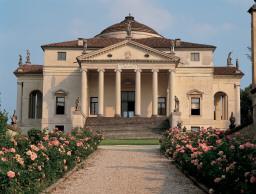An exhibition marking 500 years since the birth of groundbreaking Italian architect Andrea Palladio (1508-1580) has arrived in Spain following smash-hit stints in Italy and the UK.
The show, which traces the career of the Renaissance architect and looks at how his work revolutionized European building design, starts its eight-month period in Spain at the Caixa Forum in Barcelona, where it opens on May 22.
After Barcelona, it will travel to Madrid, where it will be on show from October 6 until January 17.
The event, Spain's first ever exhibition devoted to Palladio, seeks to draw out the Mediterranean country's links with the architect, opening with a famous painting thought to be a portrait of Palladio by the Spanish artist El Greco.
A Castilian manuscript published in Valladolid in 1625 is displayed alongside a print edition of the first of Palladio's Four Books of Architecture.
A Spanish version was the first foreign translation of the architect's renowned work, published just eight years after the original version in 1578.
However, Palladio never worked in Spain, and the only drawing he completed for a Spanish building, the church of Escorial, has vanished, so the exhibition generally offers a very broad perspective on the architect's work.
In total, over 200 items are on show, including nearly 80 signed Palladio drawings, one of the event's star attractions.
The selection provides valuable insight into Palladio's creative process and also gives visitors the chance to view a number of designs that failed to make it beyond the drawing board, either through lack of money or because they were considered too advanced for their time.
Palladio's designs for the Rialto Bridge in Venice, a new ducal palace and various of his characteristic white villas are among these.
The show features over 40 paintings, which help construct other aspects of the architect's life.
A selection of portraits by great Italian artists of the time, including Paolo Veronese, Titian and Tintoretto, depict figures from Palladio's close circle of friends, as well as his rivals, such as Jacopo Sansovino.
It also showcases a series of idealized 18th-century cityscapes by artists such as Canaletto and Francesco Zuccarelli, who often worked Palladio's structures into their paintings for foreign tourists.
The exhibition is the result of five years' preparation and spotlights a number of discoveries that emerged during this time.
PALLADIO'S PENCHANT FOR COLOUR.
Of particular interest was the discovery by top Palladian experts from Italy, Spain, France, Germany, Britain and the US that the architect had a hitherto unknown penchant for occasional outbursts of colour.
Palladio's classical designs are famous for their white simplicity but the latest research suggests that a number of works originally incorporated splashes of red.
Traces of red paint have been found on several famous buildings, including the Church of St. George in Venice, whose columns were repainted white in the mid-1600s.
Experts are now convinced that an important element of his original design for the church was the contrast between its fiery red columns and their brilliant white bases.
Palladio, who was born in Padua in 1508, is considered one of the most influential architects in Western history.
Not only did his style become fashionable all over Europe, shaping the work of British architects such as Inigo Jones and Christopher Wren, it also had a strong following in colonial America.
Born Andrea di Pietro dalla Gondola, Palladio spent time in Rome studying and measuring ancient Roman ruins, from which he took much inspiration.
Among his famous works are a series of country villas and urban palaces he designed for the provincial nobility of Vicenza.
From about 1560 to 1580 he built several churches in Venice, notably San Francesco della Vigna, San Giorgio Maggiore, and Il Redentore.
His last great work was the Teatro Olimpico in Vicenza, completed after his death in August 1580.









